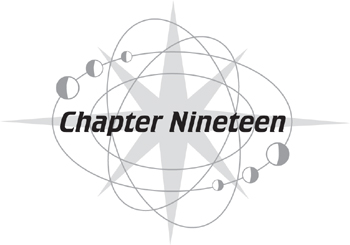
Traveling from microgravity into normal gravity isn’t a pleasant feeling, but Annie and George didn’t care. They landed, the three of them, in a heap on the floor of Old Cosmos’s basement.
“Gerroff me!” Annie pushed George and Ebot off her and rolled over. “Phew!” she said. “That was horrible.”
George lay on his back beside her. Both of them still had their eyes closed as they listened to Old Cosmos’s teletype, which had resumed its mechanical chatter, producing page after page of slowly unfurling paper.
When George finally opened his eyes, he saw that on the paper spooling by him on the floor were dense blocks of text lines of complicated math, presented like newspaper headlines (peppered with funny little numbers offset a little above and below), and also several diagrams drawn entirely out of characters—including one that looked like the space station from which they had so narrowly escaped.
The printer made a different sound as it produced these pictures, skimming quickly over large blank areas, then stopping to hammer a tiny part of the image, then shooting off to do the same thing a bit farther on, and finally flying back to start the next line.
But when George looked up, past the reams of emerging paper, a horrible sight greeted him. Standing upright, holding his tail, as well as some fresh printouts from the supercomputer, was none other than Alioth Merak. He was smirking horribly.
George’s heart sank. He squeezed Annie’s hand and she opened her eyes in shock.
They thought they’d managed to escape from terrible danger, and at the same time saved the Earth from a power-hungry man in a onesie—only to find that they had brought their deadly foe back with them. The disappointment was shattering. To see Merak here when they thought they had vanquished him . . . it was even more frightening than their first encounter with him. They had guided him to the home of Old Cosmos, and who knew what damage he might be able to do if he got control of the supercomputer? It looked as though their happy ending had gone terribly wrong.
Merak himself looked immune to fear or anxiety. He seemed perfectly relaxed. “Nanorobotic single qubit element,” he mused, reading aloud from the pages. “Operating temperature range 140 to 250 Kelvin. Accounts for space location—need to guarantee consistently low temperature range . . . Oh, so that’s why I built it in space, is it?” said Merak. “Well, that’s good to know! So glad two kids and a technological dinosaur turned up to tell me. Did you know”—he addressed the two children, who were still lying on the floor—“that 250 Kelvin is actually 9.67 degrees below zero in Fahrenheit?”